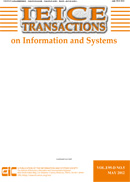Volume E93.D, Issue 2
Displaying 1-30 of 30 articles from this issue
- |<
- <
- 1
- >
- >|
Special Section on Foundations of Computer Science
-
2010Volume E93.DIssue 2 Pages 207
Published: February 01, 2010
Released on J-STAGE: February 01, 2010
Download PDF (55K) -
Article type: INVITED PAPER
2010Volume E93.DIssue 2 Pages 208-218
Published: February 01, 2010
Released on J-STAGE: February 01, 2010
Download PDF (343K) -
Article type: PAPER
2010Volume E93.DIssue 2 Pages 219-226
Published: February 01, 2010
Released on J-STAGE: February 01, 2010
Download PDF (575K) -
Article type: PAPER
2010Volume E93.DIssue 2 Pages 227-232
Published: February 01, 2010
Released on J-STAGE: February 01, 2010
Download PDF (155K) -
Article type: PAPER
2010Volume E93.DIssue 2 Pages 233-240
Published: February 01, 2010
Released on J-STAGE: February 01, 2010
Download PDF (290K) -
Article type: PAPER
2010Volume E93.DIssue 2 Pages 241-249
Published: February 01, 2010
Released on J-STAGE: February 01, 2010
Download PDF (321K) -
Article type: PAPER
2010Volume E93.DIssue 2 Pages 250-256
Published: February 01, 2010
Released on J-STAGE: February 01, 2010
Download PDF (554K) -
Article type: PAPER
2010Volume E93.DIssue 2 Pages 257-262
Published: February 01, 2010
Released on J-STAGE: February 01, 2010
Download PDF (215K) -
Article type: PAPER
2010Volume E93.DIssue 2 Pages 263-270
Published: February 01, 2010
Released on J-STAGE: February 01, 2010
Download PDF (274K) -
Article type: PAPER
2010Volume E93.DIssue 2 Pages 271-279
Published: February 01, 2010
Released on J-STAGE: February 01, 2010
Download PDF (198K) -
Article type: PAPER
2010Volume E93.DIssue 2 Pages 280-289
Published: February 01, 2010
Released on J-STAGE: February 01, 2010
Download PDF (271K) -
Article type: LETTER
2010Volume E93.DIssue 2 Pages 290-292
Published: February 01, 2010
Released on J-STAGE: February 01, 2010
Download PDF (156K)
Regular Section
-
Article type: PAPER
Subject area: Computation and Computational Models
2010Volume E93.DIssue 2 Pages 293-299
Published: February 01, 2010
Released on J-STAGE: February 01, 2010
Download PDF (800K) -
Article type: PAPER
Subject area: VLSI Systems
2010Volume E93.DIssue 2 Pages 300-305
Published: February 01, 2010
Released on J-STAGE: February 01, 2010
Download PDF (550K) -
Article type: PAPER
Subject area: Computer Systems
2010Volume E93.DIssue 2 Pages 306-314
Published: February 01, 2010
Released on J-STAGE: February 01, 2010
Download PDF (404K) -
Article type: PAPER
Subject area: Data Mining
2010Volume E93.DIssue 2 Pages 315-325
Published: February 01, 2010
Released on J-STAGE: February 01, 2010
Download PDF (399K) -
Article type: PAPER
Subject area: Artificial Intelligence and Cognitive Science
2010Volume E93.DIssue 2 Pages 326-334
Published: February 01, 2010
Released on J-STAGE: February 01, 2010
Download PDF (1006K) -
Article type: PAPER
Subject area: Educational Technology
2010Volume E93.DIssue 2 Pages 335-340
Published: February 01, 2010
Released on J-STAGE: February 01, 2010
Download PDF (169K) -
Article type: PAPER
Subject area: Speech and Hearing
2010Volume E93.DIssue 2 Pages 341-349
Published: February 01, 2010
Released on J-STAGE: February 01, 2010
Download PDF (781K) -
Article type: PAPER
Subject area: Image Processing and Video Processing
2010Volume E93.DIssue 2 Pages 350-358
Published: February 01, 2010
Released on J-STAGE: February 01, 2010
Download PDF (530K) -
Article type: PAPER
Subject area: Image Processing and Video Processing
2010Volume E93.DIssue 2 Pages 359-366
Published: February 01, 2010
Released on J-STAGE: February 01, 2010
Download PDF (1293K) -
Article type: PAPER
Subject area: Image Processing and Video Processing
2010Volume E93.DIssue 2 Pages 367-375
Published: February 01, 2010
Released on J-STAGE: February 01, 2010
Download PDF (940K) -
Article type: LETTER
Subject area: Software Engineering
2010Volume E93.DIssue 2 Pages 376-379
Published: February 01, 2010
Released on J-STAGE: February 01, 2010
Download PDF (296K) -
Article type: LETTER
Subject area: Dependable Computing
2010Volume E93.DIssue 2 Pages 380-383
Published: February 01, 2010
Released on J-STAGE: February 01, 2010
Download PDF (124K) -
Article type: LETTER
Subject area: Pattern Recognition
2010Volume E93.DIssue 2 Pages 384-387
Published: February 01, 2010
Released on J-STAGE: February 01, 2010
Download PDF (439K) -
Article type: LETTER
Subject area: Speech and Hearing
2010Volume E93.DIssue 2 Pages 388-391
Published: February 01, 2010
Released on J-STAGE: February 01, 2010
Download PDF (554K) -
Article type: LETTER
Subject area: Speech and Hearing
2010Volume E93.DIssue 2 Pages 392-394
Published: February 01, 2010
Released on J-STAGE: February 01, 2010
Download PDF (199K) -
Article type: LETTER
Subject area: Speech and Hearing
2010Volume E93.DIssue 2 Pages 395-398
Published: February 01, 2010
Released on J-STAGE: February 01, 2010
Download PDF (79K) -
Article type: LETTER
Subject area: Image Processing and Video Processing
2010Volume E93.DIssue 2 Pages 399-402
Published: February 01, 2010
Released on J-STAGE: February 01, 2010
Download PDF (335K) -
Article type: LETTER
Subject area: Image Processing and Video Processing
2010Volume E93.DIssue 2 Pages 403-406
Published: February 01, 2010
Released on J-STAGE: February 01, 2010
Download PDF (584K)
- |<
- <
- 1
- >
- >|
